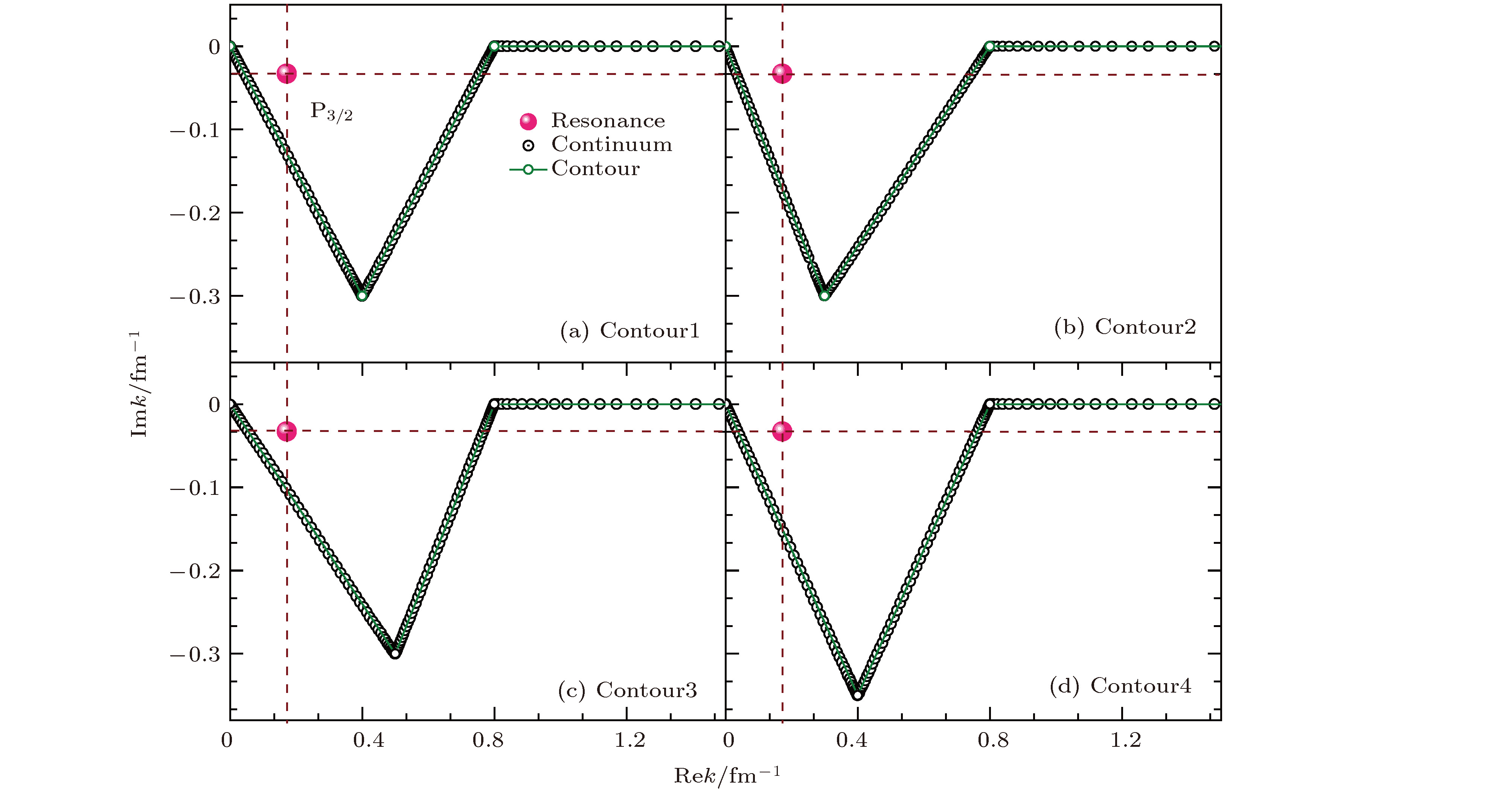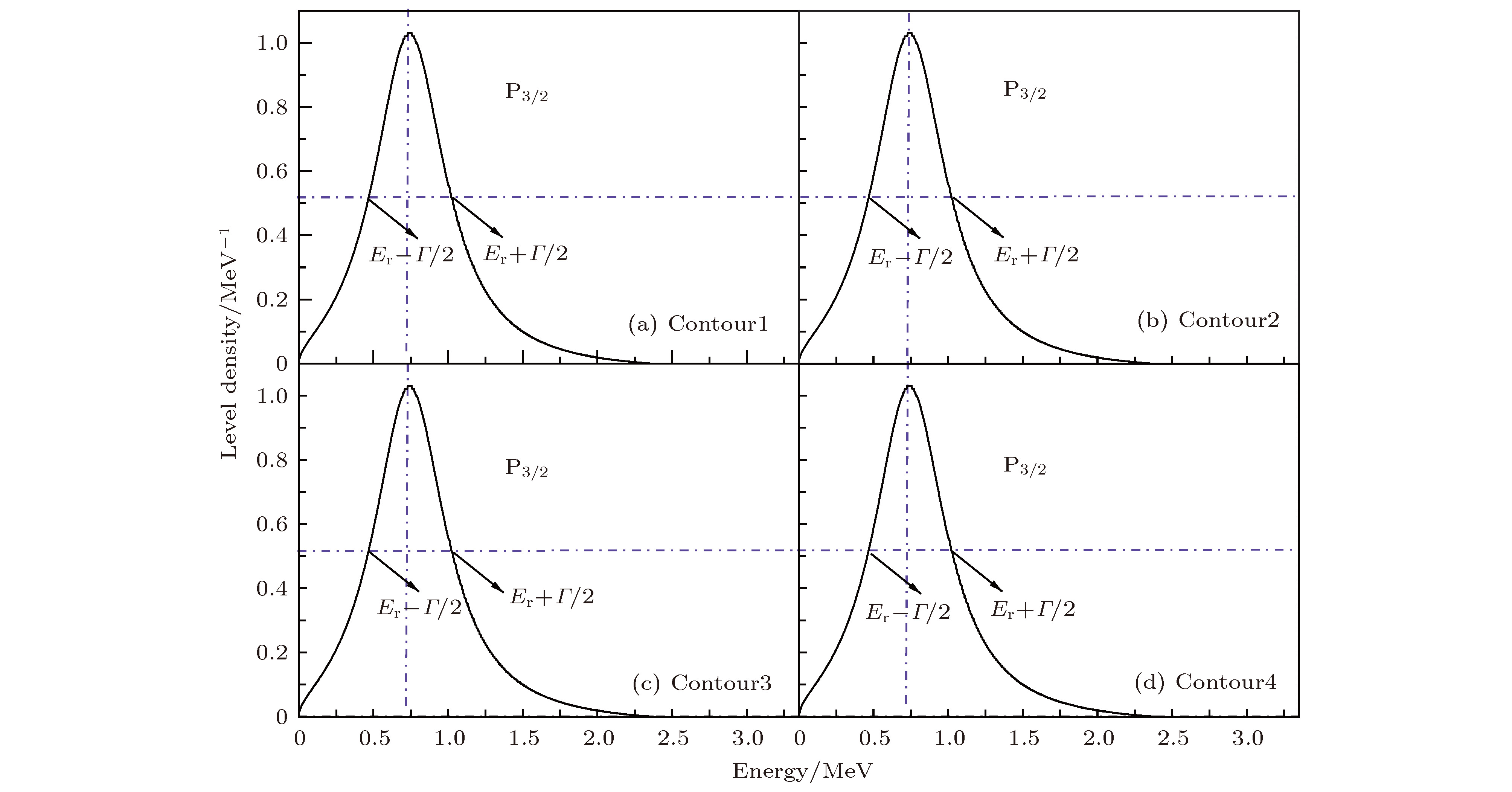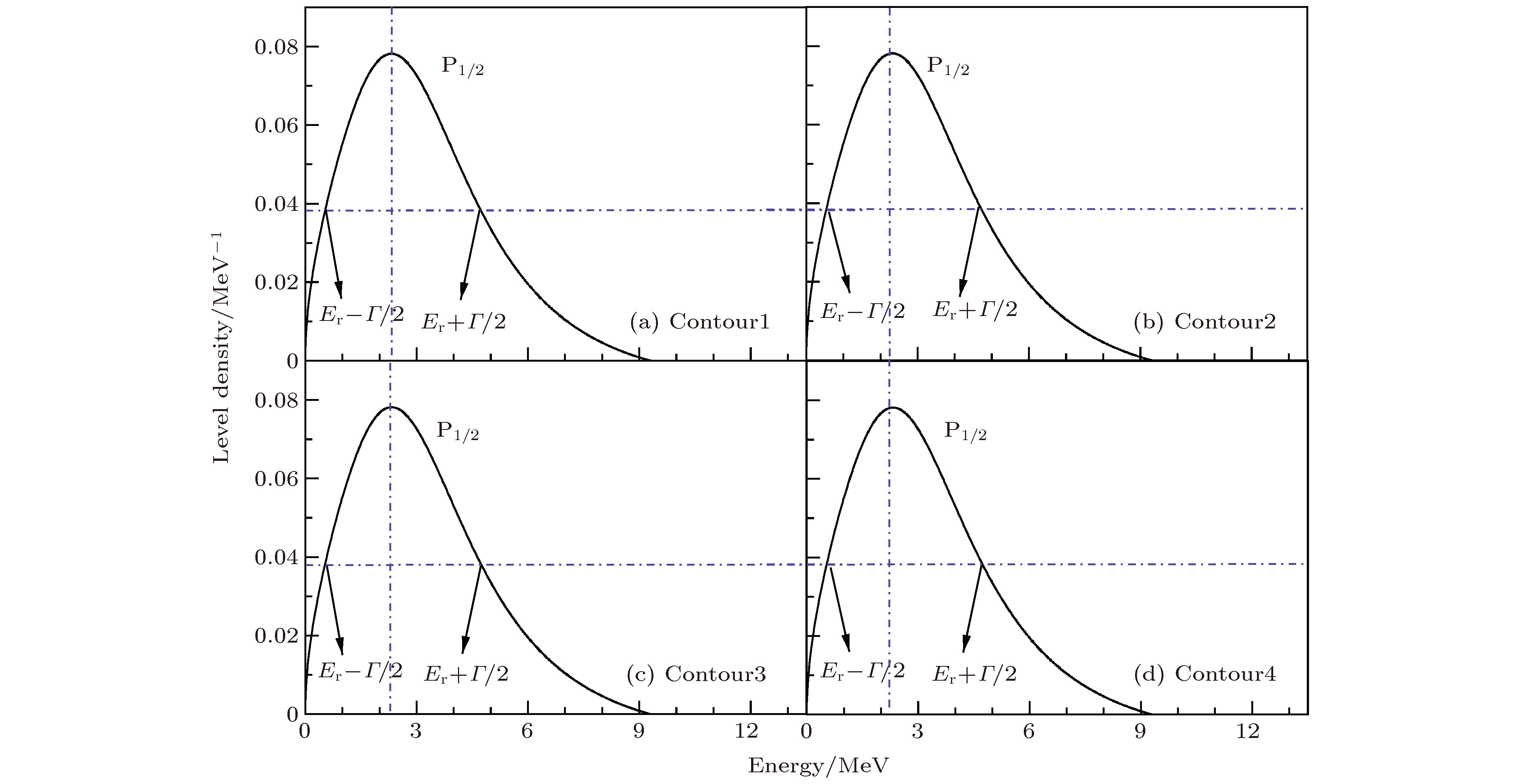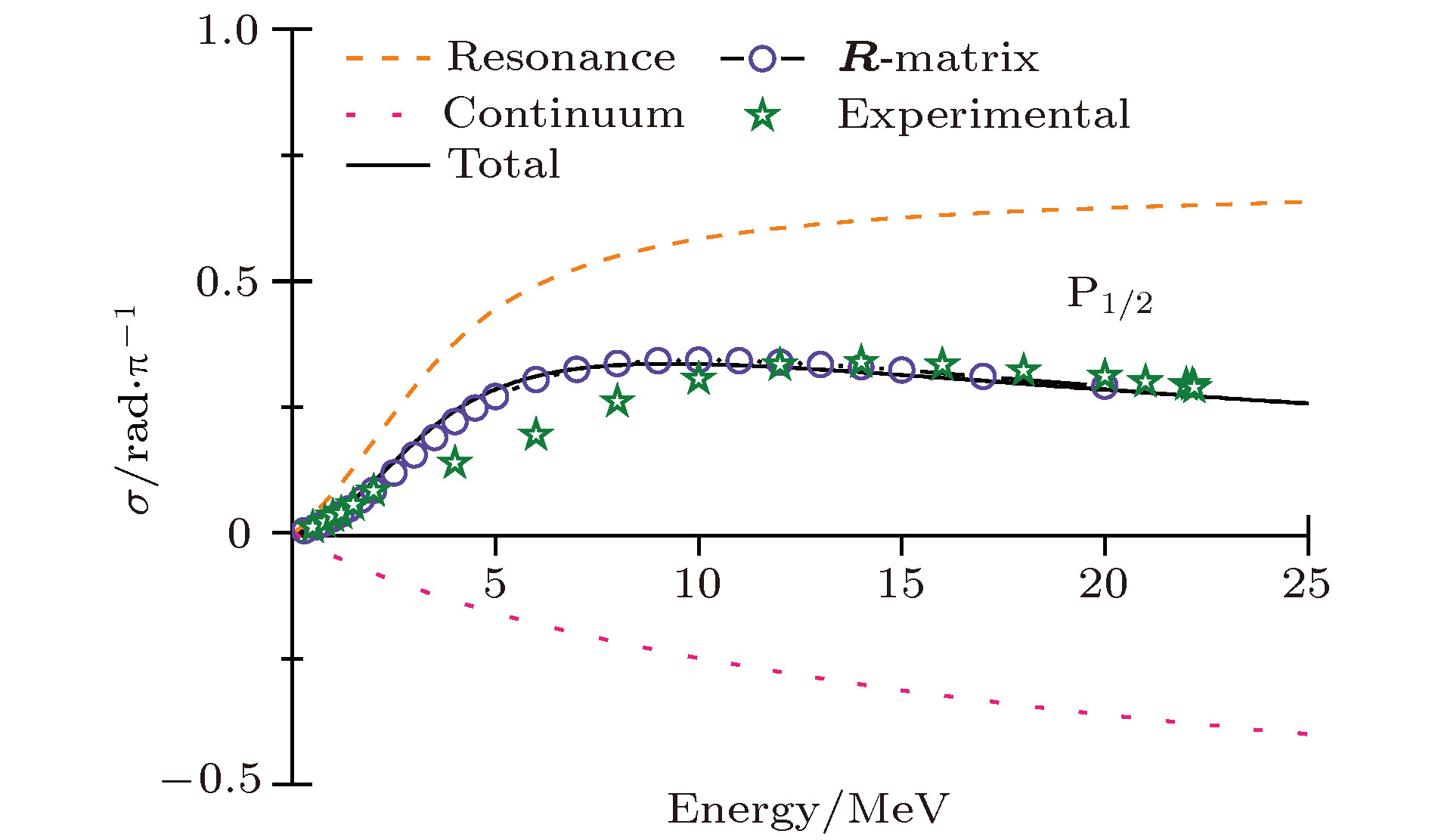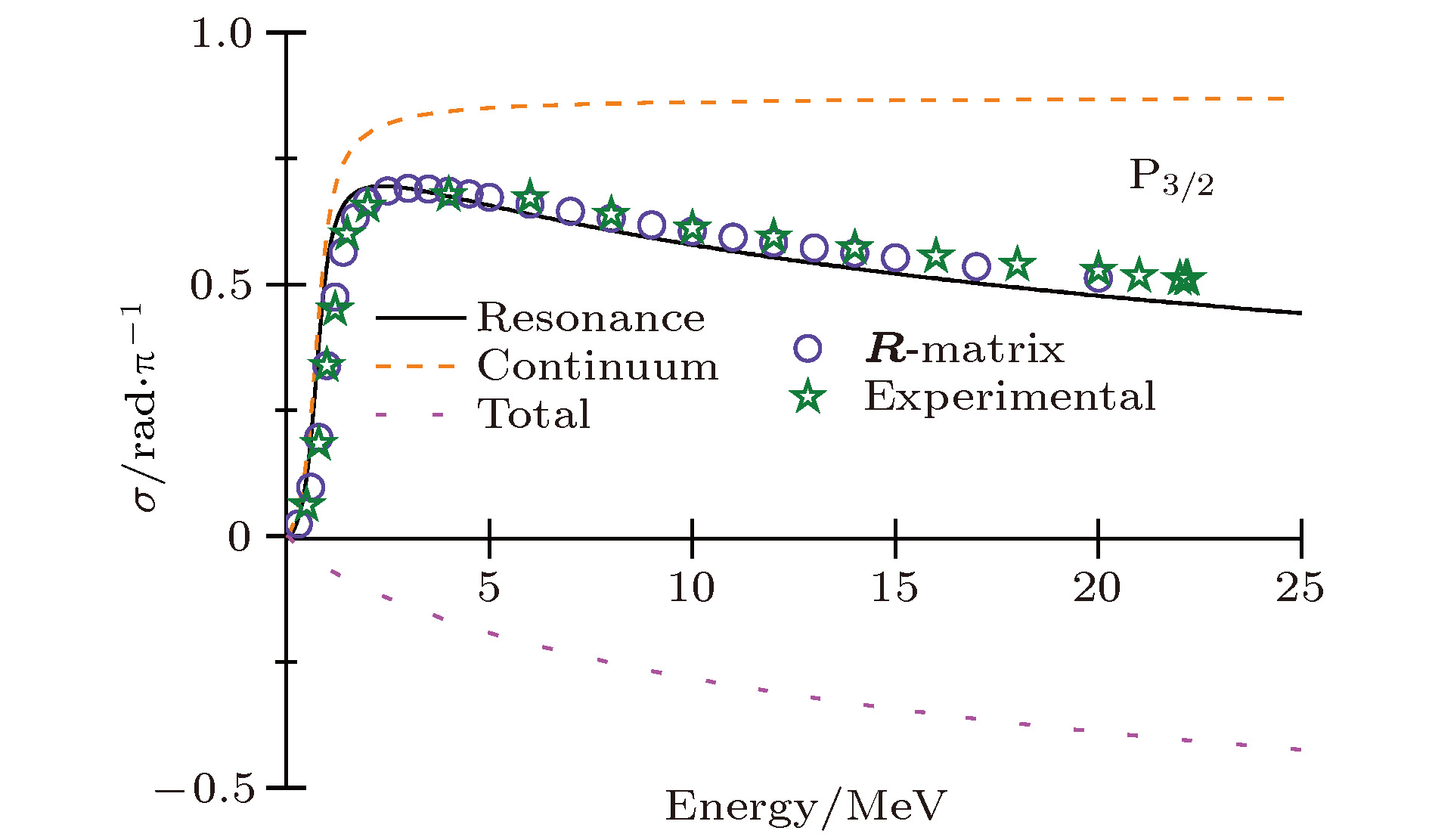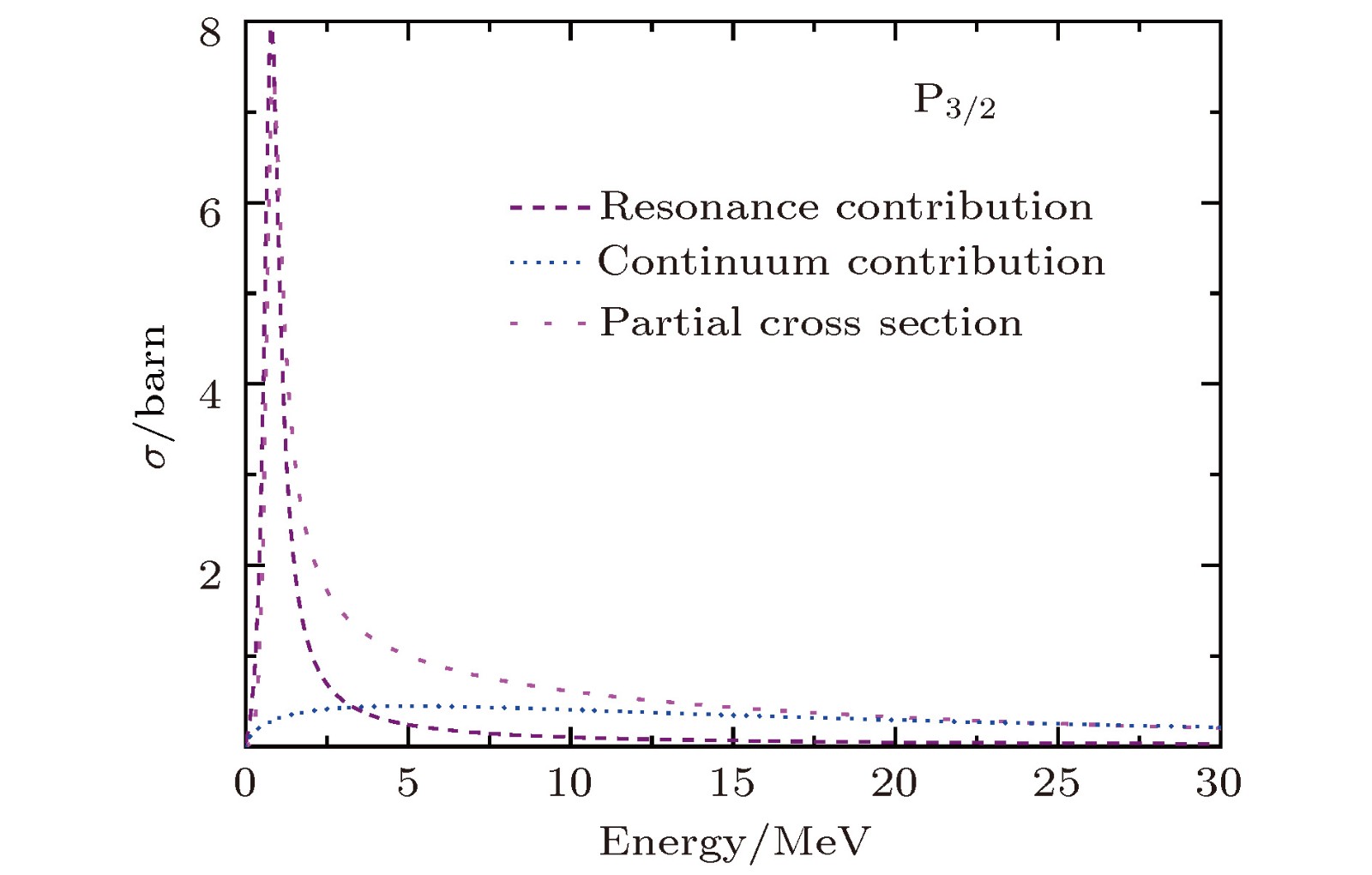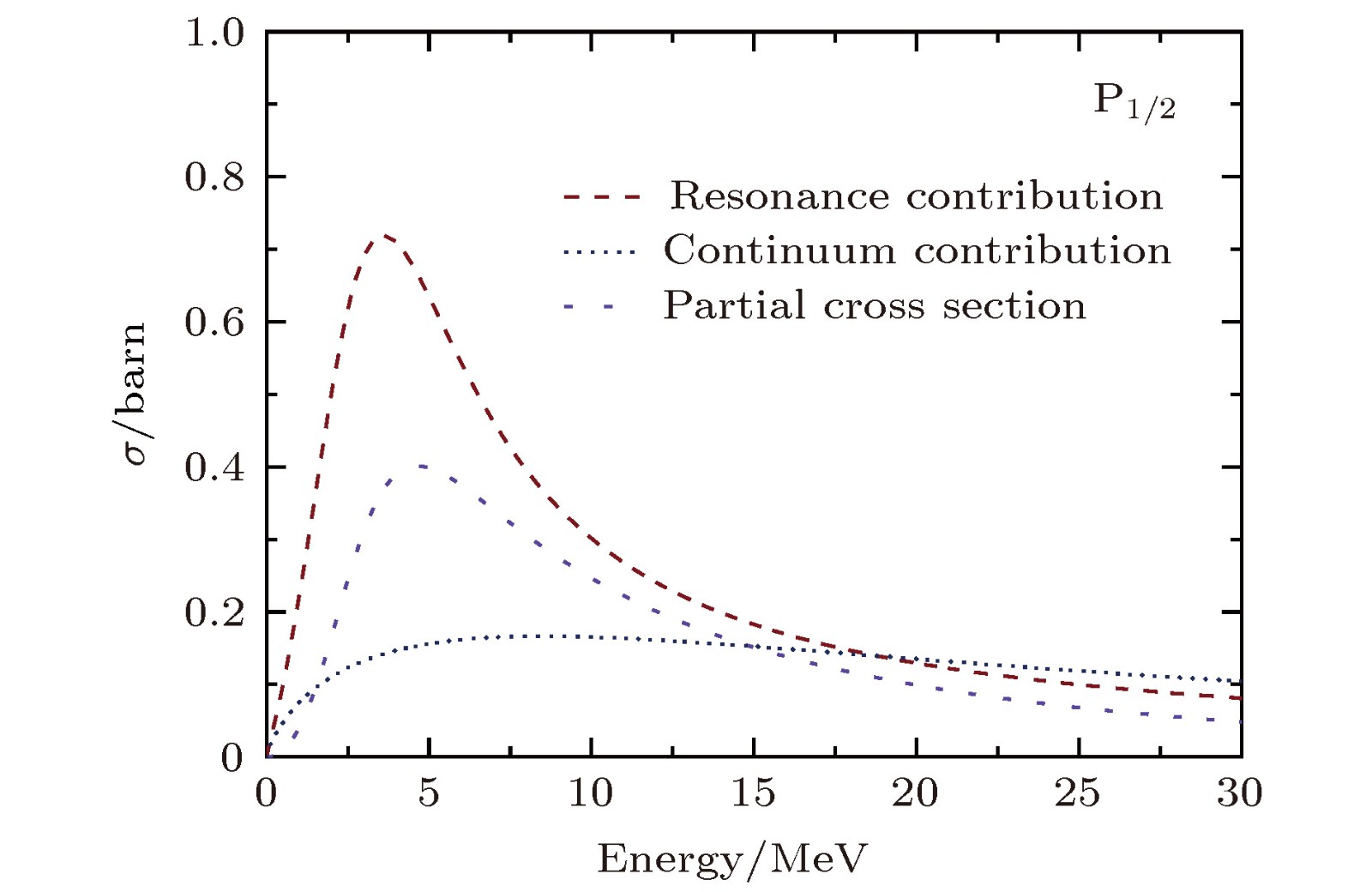-
Nuclear scattering is a very important physical phenomenon in which the resonance state plays an important role. In order to study the two-body system n-α scattering, Green’s function is introduced under the complex momentum representation, so the complex momentum representation-Green’s function approach is established. This method is used to study the elastic scattering of n-α system. By extracting the resonances, it is found that the contributions of resonances in continuum level density, phase shift, and cross section are more important. In the case without introducing any non-physical parameters, it is very helpful to understand the resonant states and the non-resonance continuum states by analyzing the data of scattering states. In this work, we mainly study the p-wave scattering with the orbital angular momentum l = 1, where P1/2 is a wide resonance state and P3/2 is narrow resonance state. The study shows that the sharp resonance peak of p-wave scattering gives rather broad distribution to the scattering phase shift and the cross section of the n-α system. By comparison, we can see that the theoretical calculation results and experimental data are in good consistence.
-
Keywords:
- complex momentum representation-Green’s function /
- resonant states /
- scattering phase shift /
- cross section
[1] Tanihata I 1996 J. Phys. G 22 157
 Google Scholar
Google Scholar
[2] Ryusuke S, Takayuki M, Kiyoshi K 2005 Prog. Theor. Phys. 113 1273
 Google Scholar
Google Scholar
[3] Kiyoshi K, Masayuki A 2014 Phys. Rev. C 89 034322
 Google Scholar
Google Scholar
[4] Wigner E P, Eisenbud L 1947 Phys. Rev. 72 29
 Google Scholar
Google Scholar
[5] Hale G M, Brown R E, Jarmie N 1987 Phys. Lett. 59 763
 Google Scholar
Google Scholar
[6] Humblet J, Filippone B W, Koonin S E 1991 Phys. Rev. C 44 2530
 Google Scholar
Google Scholar
[7] Taylor J R, Wiley J 1972 Scattering Theory: The Quantum Theory on Non-relativistic Collisions (New York: Inc. Mineola) pp204−207
[8] Amos K, Canton L, Pisent G, Svenne J P, van der Knijff D 2003 Nucl. Phys. A 728 65
 Google Scholar
Google Scholar
[9] Guo J Y, Fang X Z, Jiao P, Wang J, Yao B M 2010 Phys. Rev. C 82 034318
 Google Scholar
Google Scholar
[10] Lu B N, Zhao E G, Zhou S G 2012 Phys. Rev. Lett. 109 072501
 Google Scholar
Google Scholar
[11] Lu B N, Zhao E G, Zhou S G 2013 Phys. Rev. C 88 024323
 Google Scholar
Google Scholar
[12] Shi M, Liu Q, Niu Z M, Gou J Y 2014 Phys. Rev. C 90 034319
 Google Scholar
Google Scholar
[13] Zhu Z L, Niu Z M, Li D P, Liu Q, Guo J Y 2014 Phys. Rev. C 89 034307
 Google Scholar
Google Scholar
[14] Liu Q, Guo J Y, Niu Z M, Chen S W 2012 Phys. Rev. C 86 054312
 Google Scholar
Google Scholar
[15] Wang H Y, Chang X U 2016 Nucl. Phys. Rev. 33 1
[16] Jolly R K, Amos T M, Galonsky A 1973 Phys. Rev. C 7 1903
 Google Scholar
Google Scholar
[17] Brussel M K, Williams J H 1957 Phys. Rev. C 106 286
 Google Scholar
Google Scholar
[18] Hwang C F 1962 Phys. Rev. Lett. 9 104
 Google Scholar
Google Scholar
[19] May T H, Walter R L, Barschall H H 1963 Nucl. Phys. 45 17
 Google Scholar
Google Scholar
[20] Craddock M K 1963 Phys. Lett. 5 335
 Google Scholar
Google Scholar
[21] Barnard A C L, Jones C M, Weil J L 1964 Nucl. Phys. 50 604
 Google Scholar
Google Scholar
[22] Bunch S M, Forster H H, Kim C C 1964 Nucl. Phys. 53 241
 Google Scholar
Google Scholar
[23] Morgan G L 1968 Phys. Rev. 168 114
 Google Scholar
Google Scholar
[24] Garreta D, Sura J, Tarrats A 1969 Nucl. Phys. A 132 204
 Google Scholar
Google Scholar
[25] Goldstein N P, Held A, Stairs D G 1970 Can. J. Phys. 48 2629
 Google Scholar
Google Scholar
[26] Schwandt P, Clegg T B, Haeberli W 1971 Nucl. Phys. A 163 432
 Google Scholar
Google Scholar
[27] Bacher A D 1972 Phys. Rev. C 5 1147
 Google Scholar
Google Scholar
[28] Austin S M, Barschall H H, Shamu R E 1962 Phys. Rev. 126 1532
 Google Scholar
Google Scholar
[29] Shi X X, Shi M, Heng T H 2016 Phys. Rev. C 94 024302
 Google Scholar
Google Scholar
[30] Li N, Shi M, Guo J Y, Niu Z M, Liang H Z 2016 Phys. Rev. Lett. 117 062502
 Google Scholar
Google Scholar
[31] Fang Z, Shi M, Guo J Y, Niu Z M, Liang H Z, Zhang S S 2017 Phys. Rev. C 95 024311
 Google Scholar
Google Scholar
[32] Ding K M, Shi M, Guo J Y, Niu Z M, Liang H Z 2018 Phys. Rev. C 98 014316
 Google Scholar
Google Scholar
[33] Shi M, Niu Z M, Liang H Z 2018 Phys. Rev. C 97 064301
 Google Scholar
Google Scholar
[34] Ali S, Bodmer A R 1966 Nucl. Phys. 80 99
 Google Scholar
Google Scholar
[35] Marquez L 1983 Phys. Rev. C 28 2525
 Google Scholar
Google Scholar
[36] Mohr P 1994 Z. Phys. A 349 339
 Google Scholar
Google Scholar
[37] Shlomo S 1992 Nucl. Phys. A 539 17
 Google Scholar
Google Scholar
[38] Levine R D 1969 Quantum Mechanics of Molecular Rate Processes (Oxford: Clarendon Press Oxford) pp101−106
[39] Haberzettl H, Workman R 2007 Phys. Rev. C 76 058201
 Google Scholar
Google Scholar
[40] Hamamoto I 2010 Phys. Rev. C 81 021304(R)
 Google Scholar
Google Scholar
[41] Fano U 1961 Phys. Rev. 124 1866
 Google Scholar
Google Scholar
[42] Meng J, Ring P 1996 Rev. Lett. 77 3963
 Google Scholar
Google Scholar
[43] Sandulesu N, Van Giai N, Liotta R J 2000 Phys. Rev. C 61 061301
 Google Scholar
Google Scholar
[44] Kanada H, Kaneko T, Nagata S, Nomoto M 1979 Prog. Theor. Phys. 61 1327
 Google Scholar
Google Scholar
[45] Kruppa A T 1998 Phys. Lett. B 431 237
 Google Scholar
Google Scholar
[46] Kruppa A T, Arai K 1999 Phys. Rev. A 59 3556
 Google Scholar
Google Scholar
[47] Myo T, Kikuchi Y, Masui H, Kato K 2014 Prog. Part. Nucl. Phys. 79 1
 Google Scholar
Google Scholar
[48] Shi M, Guo J Y, Liu Q, Niu Z M, Heng T H 2015 Phys. Rev. C 92 054313
 Google Scholar
Google Scholar
[49] Shi M, Shi X X, Niu Z M, Sun T T, Guo J M 2017 Eur. Phys. J. A 53 40
 Google Scholar
Google Scholar
[50] Tilley D R, Cheves C M, Godwin J L, et al. 2002 Nucl. Phys. A 708 3
 Google Scholar
Google Scholar
[51] Hoop B, Barschall H H 1966 Nucl. Phys. 83 65
 Google Scholar
Google Scholar
[52] Stammbach T, Walter R L 1972 Nucl. Phys. A 180 225
 Google Scholar
Google Scholar
[53] Vaughn F J, Imhof W L, Johnson R G, Walt M 1960 Phys. Rev. 118 683
 Google Scholar
Google Scholar
[54] Los Alamos P, Gryogenics G 1959 Nucl. Phys. 12 291
 Google Scholar
Google Scholar
-
图 1 用CMR-GF方法在4种不同积分路径下计算得到的n-α系统的
$\rm P_{{1/2}}$ 轨道的单粒子共振态, 图中红色五角星代表共振态, 点心圆圈代表非共振连续谱, 绿色实线代表动量平面内的积分路径Figure 1. Single particle resonance states for
$\rm P_{1/2}$ orbital of n-α systems calculated by using CMR-GF method under four different integral paths. The red pentagram represents the resonant state, the circle represents the continuum, and the green solid line represents the integral path in the momentum plane.图 2 同图1所示, 计算得到的n-α系统的
$\rm P_{3/2}$ 轨道的单粒子共振态, 图中红色圆球代表共振态, 点心圆圈代表非共振连续谱, 绿色实线代表是动量平面内的积分路径Figure 2. Single particle resonance states for
$\rm P_{3/2}$ orbital of n-α systems. The red sphere represents the resonant state, the circle represents the continuum, and the green solid line represents the integral path in the momentum plane.图 5 n-α散射系统的
${\rm{P}}_{1/2}$ 态的相移(橘色长虚线表示共振态散射相移, 红色短虚线表示连续谱散射相移, 黑色实线表示总散射相移, 紫色圆圈表示由R矩阵理论计算所得散射相移, 绿色五角星表示实验上的相移)Figure 5. The
${\rm{P}}_{1/2}$ phase shift of n-α scattering system. The orange long dotted line represents the resonant scattering phase shift, the red short dotted line represents the continuum scattering phase shift, the black solid line represents the total scattering phase shift, the purple circle represents the scattering phase shift calculated by R matrix theory, and the green stars represent the experimental data of the total scattering phase shift.图 6 n-α散射系统的
${\rm{P}}_{3/2}$ 态的相移(橘色长虚线表示共振态散射相移, 红色短虚线表示连续谱散射相移, 黑色实线表示总散射相移, 紫色圆圈表示由R矩阵理论计算所得散射相移, 绿色五角星表示实验上的相移)Figure 6. The
${\rm{P}}_{3/2}$ phase shift of n-α scattering system. The orange long dotted line represents the resonant scattering phase shift, the red short dotted line represents the continuum scattering phase shift, the black solid line represents the total scattering phase shift, the purple circle represents the scattering phase shift calculated by R matrix theory, and the green stars represent the experimental data of the total scattering phase shift.表 1 n-α散射KKNN势参数
Table 1. Parameters of the n-α KKNN potential
$V^{\rm {\rm {c}}}$/MeV $ {\mu}^{\rm {c}} /{{\rm{f}}{{\rm{m}}^{ - 2}}}$ $ V_{l}^{\rm {c}}\!$/MeV $ {\mu}_{ {l}}^{\rm {c}} /{{\rm{f}}{{\rm{m}}^{ - 2}}} $ $ -96.3 $ $ 0.36 $ $ 34.0 $ $ 0.20 $ Central $ 77.0 $ $ 0.90 $ $ -85.0 $ $ 0.53 $ $ 51.0 $ $ 2.50 $ $V^{\rm{ls}}$/MeV ${\mu}^{ \rm{ls}} /{{\rm{f}}{{\rm{m}}^{ - 2}}}$ $V_{ {l}}^{ \rm{ls}}$/MeV ${\mu}_{ {l}}^{\rm{ls}} /{{\rm{f}}{{\rm{m}}^{ - 2}}}$ Spin-orbit $ -16.8 $ $ 0.52 $ $ -20.0 $ $ 0.396 $ $ 20.0 $ $ 2.200 $ -
[1] Tanihata I 1996 J. Phys. G 22 157
 Google Scholar
Google Scholar
[2] Ryusuke S, Takayuki M, Kiyoshi K 2005 Prog. Theor. Phys. 113 1273
 Google Scholar
Google Scholar
[3] Kiyoshi K, Masayuki A 2014 Phys. Rev. C 89 034322
 Google Scholar
Google Scholar
[4] Wigner E P, Eisenbud L 1947 Phys. Rev. 72 29
 Google Scholar
Google Scholar
[5] Hale G M, Brown R E, Jarmie N 1987 Phys. Lett. 59 763
 Google Scholar
Google Scholar
[6] Humblet J, Filippone B W, Koonin S E 1991 Phys. Rev. C 44 2530
 Google Scholar
Google Scholar
[7] Taylor J R, Wiley J 1972 Scattering Theory: The Quantum Theory on Non-relativistic Collisions (New York: Inc. Mineola) pp204−207
[8] Amos K, Canton L, Pisent G, Svenne J P, van der Knijff D 2003 Nucl. Phys. A 728 65
 Google Scholar
Google Scholar
[9] Guo J Y, Fang X Z, Jiao P, Wang J, Yao B M 2010 Phys. Rev. C 82 034318
 Google Scholar
Google Scholar
[10] Lu B N, Zhao E G, Zhou S G 2012 Phys. Rev. Lett. 109 072501
 Google Scholar
Google Scholar
[11] Lu B N, Zhao E G, Zhou S G 2013 Phys. Rev. C 88 024323
 Google Scholar
Google Scholar
[12] Shi M, Liu Q, Niu Z M, Gou J Y 2014 Phys. Rev. C 90 034319
 Google Scholar
Google Scholar
[13] Zhu Z L, Niu Z M, Li D P, Liu Q, Guo J Y 2014 Phys. Rev. C 89 034307
 Google Scholar
Google Scholar
[14] Liu Q, Guo J Y, Niu Z M, Chen S W 2012 Phys. Rev. C 86 054312
 Google Scholar
Google Scholar
[15] Wang H Y, Chang X U 2016 Nucl. Phys. Rev. 33 1
[16] Jolly R K, Amos T M, Galonsky A 1973 Phys. Rev. C 7 1903
 Google Scholar
Google Scholar
[17] Brussel M K, Williams J H 1957 Phys. Rev. C 106 286
 Google Scholar
Google Scholar
[18] Hwang C F 1962 Phys. Rev. Lett. 9 104
 Google Scholar
Google Scholar
[19] May T H, Walter R L, Barschall H H 1963 Nucl. Phys. 45 17
 Google Scholar
Google Scholar
[20] Craddock M K 1963 Phys. Lett. 5 335
 Google Scholar
Google Scholar
[21] Barnard A C L, Jones C M, Weil J L 1964 Nucl. Phys. 50 604
 Google Scholar
Google Scholar
[22] Bunch S M, Forster H H, Kim C C 1964 Nucl. Phys. 53 241
 Google Scholar
Google Scholar
[23] Morgan G L 1968 Phys. Rev. 168 114
 Google Scholar
Google Scholar
[24] Garreta D, Sura J, Tarrats A 1969 Nucl. Phys. A 132 204
 Google Scholar
Google Scholar
[25] Goldstein N P, Held A, Stairs D G 1970 Can. J. Phys. 48 2629
 Google Scholar
Google Scholar
[26] Schwandt P, Clegg T B, Haeberli W 1971 Nucl. Phys. A 163 432
 Google Scholar
Google Scholar
[27] Bacher A D 1972 Phys. Rev. C 5 1147
 Google Scholar
Google Scholar
[28] Austin S M, Barschall H H, Shamu R E 1962 Phys. Rev. 126 1532
 Google Scholar
Google Scholar
[29] Shi X X, Shi M, Heng T H 2016 Phys. Rev. C 94 024302
 Google Scholar
Google Scholar
[30] Li N, Shi M, Guo J Y, Niu Z M, Liang H Z 2016 Phys. Rev. Lett. 117 062502
 Google Scholar
Google Scholar
[31] Fang Z, Shi M, Guo J Y, Niu Z M, Liang H Z, Zhang S S 2017 Phys. Rev. C 95 024311
 Google Scholar
Google Scholar
[32] Ding K M, Shi M, Guo J Y, Niu Z M, Liang H Z 2018 Phys. Rev. C 98 014316
 Google Scholar
Google Scholar
[33] Shi M, Niu Z M, Liang H Z 2018 Phys. Rev. C 97 064301
 Google Scholar
Google Scholar
[34] Ali S, Bodmer A R 1966 Nucl. Phys. 80 99
 Google Scholar
Google Scholar
[35] Marquez L 1983 Phys. Rev. C 28 2525
 Google Scholar
Google Scholar
[36] Mohr P 1994 Z. Phys. A 349 339
 Google Scholar
Google Scholar
[37] Shlomo S 1992 Nucl. Phys. A 539 17
 Google Scholar
Google Scholar
[38] Levine R D 1969 Quantum Mechanics of Molecular Rate Processes (Oxford: Clarendon Press Oxford) pp101−106
[39] Haberzettl H, Workman R 2007 Phys. Rev. C 76 058201
 Google Scholar
Google Scholar
[40] Hamamoto I 2010 Phys. Rev. C 81 021304(R)
 Google Scholar
Google Scholar
[41] Fano U 1961 Phys. Rev. 124 1866
 Google Scholar
Google Scholar
[42] Meng J, Ring P 1996 Rev. Lett. 77 3963
 Google Scholar
Google Scholar
[43] Sandulesu N, Van Giai N, Liotta R J 2000 Phys. Rev. C 61 061301
 Google Scholar
Google Scholar
[44] Kanada H, Kaneko T, Nagata S, Nomoto M 1979 Prog. Theor. Phys. 61 1327
 Google Scholar
Google Scholar
[45] Kruppa A T 1998 Phys. Lett. B 431 237
 Google Scholar
Google Scholar
[46] Kruppa A T, Arai K 1999 Phys. Rev. A 59 3556
 Google Scholar
Google Scholar
[47] Myo T, Kikuchi Y, Masui H, Kato K 2014 Prog. Part. Nucl. Phys. 79 1
 Google Scholar
Google Scholar
[48] Shi M, Guo J Y, Liu Q, Niu Z M, Heng T H 2015 Phys. Rev. C 92 054313
 Google Scholar
Google Scholar
[49] Shi M, Shi X X, Niu Z M, Sun T T, Guo J M 2017 Eur. Phys. J. A 53 40
 Google Scholar
Google Scholar
[50] Tilley D R, Cheves C M, Godwin J L, et al. 2002 Nucl. Phys. A 708 3
 Google Scholar
Google Scholar
[51] Hoop B, Barschall H H 1966 Nucl. Phys. 83 65
 Google Scholar
Google Scholar
[52] Stammbach T, Walter R L 1972 Nucl. Phys. A 180 225
 Google Scholar
Google Scholar
[53] Vaughn F J, Imhof W L, Johnson R G, Walt M 1960 Phys. Rev. 118 683
 Google Scholar
Google Scholar
[54] Los Alamos P, Gryogenics G 1959 Nucl. Phys. 12 291
 Google Scholar
Google Scholar
Catalog
Metrics
- Abstract views: 10857
- PDF Downloads: 68
- Cited By: 0














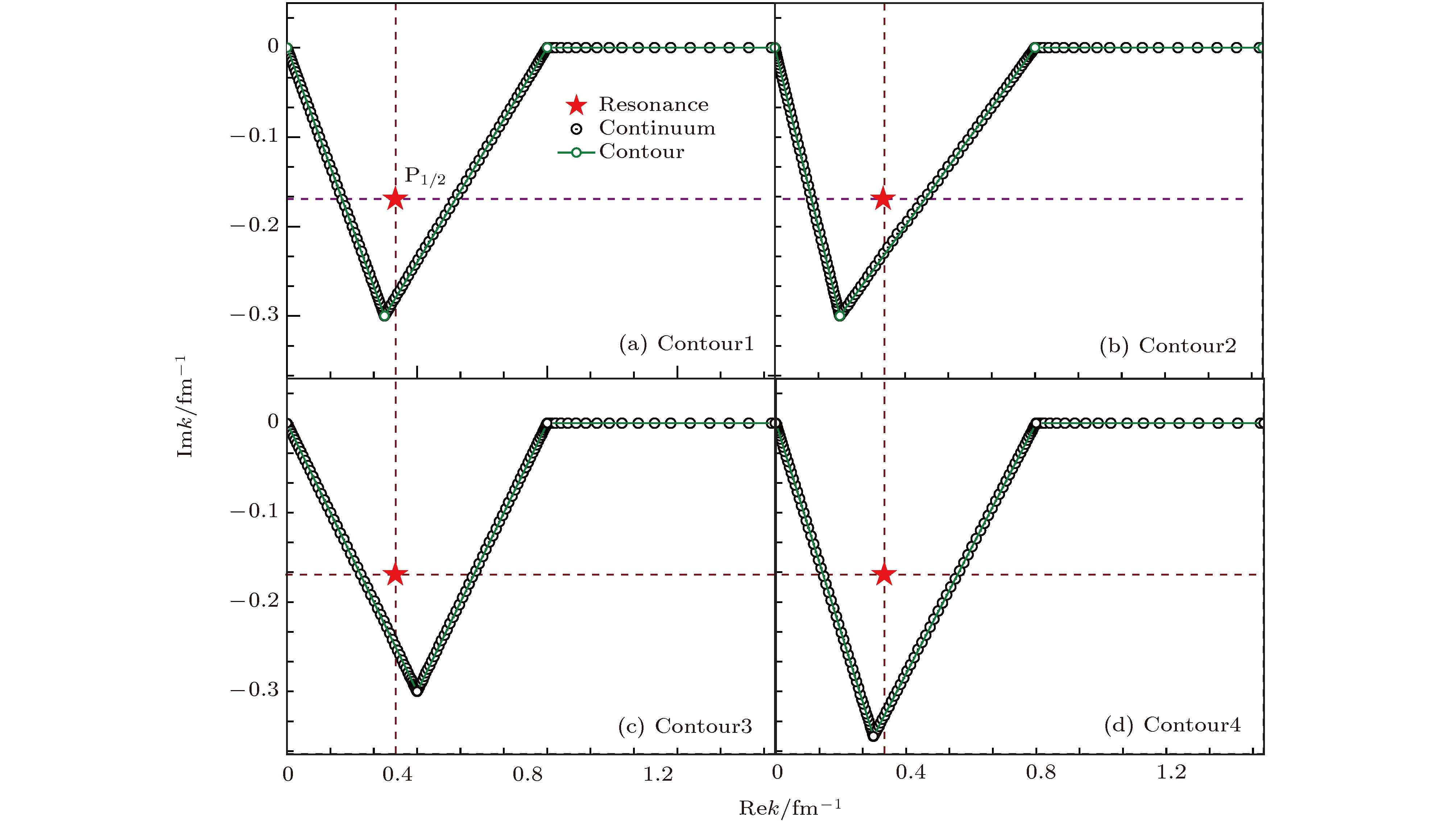


 DownLoad:
DownLoad:
